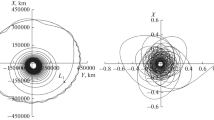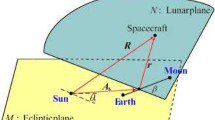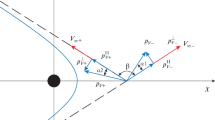Abstract
The study considers the problem of calculating the low-energy trajectories of a low-thrust spacecraft to the Moon during the ballistic capture. The transfer is carried out using a transit trajectory in the vicinity of one of the collinear libration points L1 or L2 of the Earth-Moon system. Using a transit trajectory allows us to reduce fuel consumptions for the transfer by applying spacecraft dynamic in the Earth-Moon system. After exit from the orbit of ballistic capture, depending on the goal of mission the required lunar orbit can be formed, or the maneuver can be completed for inserting into the required interplanetary trajectory. A method for solving the problem is proposed, which consists in selecting the suitable transit trajectory to ensure sufficiently long duration of staying a spacecraft in the sphere of influence of the Moon, and in calculating the optimal low-thrust trajectories from initial lunar orbit to the transit trajectory to the Moon. To solve the problem of optimal control and calculate the optimal exit point to the transit trajectory, the Pontryagin’s maximum principle is used in combination with the continuation method by parameter. Numerical examples are given for calculating low-energy trajectories to the Moon during the ballistic capture with the optimization of exit point to the transit trajectory.















Similar content being viewed by others
REFERENCES
Egorov, V.A., On some problems of the dynamics of flight to the Moon, Usp. Fiz. Nauk, 1957, vol. 43, no. 1, pp. 73–117.
Egorov, V.A., On the question of capture in the restricted circular three-point problem, Iskusstv. Sputniki Zemli, 1959, no. 3, pp. 3–12.
Egorov, V.A., Prostranstvennaya zadacha dostizheniya Luny (Spatial Problem of Reaching the Moon), Moscow: Nauka, 1965.
Egorov, V.A. and Gusev, L.I., Dinamika pereletov mezhdu Zemlei i Lunoi (Dynamics of Transfers between the Earth and the Moon), Moscow: Nauka, 1980.
Fesenkov, V.G., On the possibility of capturing at close range, Astron. Zh., 1946, vol. 23, no. 1, pp. 45–58.
Davidson, M.C., Numerical examples of transition orbits in the restricted three body problem, Astronaut. Act-a, 1964, no. 10, pp. 308–313.
Alekseev, V.M., Lektsii po nebesnoi mekhanike (Lectures on Celestial Mechanics), Izhevsk: Izhevsk. Resp. Tipogr., 1999.
Belbruno, E.A., Lunar capture orbits, a method of constructing Earth–Moon trajectories and the lunar GAS mission, 19th AIAA/DGLR/JSASS Int. Electric Propulsion Conf., May 11–13, 1987, Colorado Springs, CO, Takegahara, H., Shimada, S., and Kimura, H., Eds., Washington, 1987, p. 87-1054. https://doi.org/10.2514/6.1987-1054
Belbruno, E.A. and Miller, J.K., Sun-perturbed Earth-to-Moon transfers with ballistic capture, J. Guid., Control Dyn., 1993, vol. 16, no. 4, pp. 770–775.
Ivashkin, V.V., On the optimal trajectories of spacecraft flight to the Moon in the Earth–Moon–Sun system, Preprint of Keldysh Inst. Appl. Math., 2001, no. 85.
Ivashkin, V.V., On the transfer trajectories of a point to the Moon with its temporary capture by the Moon, Dokl. Akad. Nauk, 2002, vol. 387, no. 2, pp. 196–199.
Ivashkin, V.V., On the transfer trajectories of a point from the Moon to the Earth with gravitational release from the lunar attraction, Dokl. Akad. Nauk, 2004, vol. 398, no. 3, pp. 340–343.
Ivashkin, V.V., Low energy trajectories for the Moon-to-Earth space flight, J. Earth Syst. Sci., 2005, vol. 114, no. 6, pp. 613–618. https://doi.org/10.1007/BF02715945
El’nikov, R.V., Use of the Lyapunov functions for calculating the locally optimal control of a thrust vector during low-thrust interorbital transfer, Cosmic Res., 2021, vol. 59, no. 3, pp. 212–221. https://doi.org/10.1134/S0010952521030035
Shannon, J., Ozimek, M., Atchison, J., and Hartzell, C., Rapid design and exploration of high-fidelity low-thrust transfers to the Moon, IEEE Aerospace Conf., Big Sky, Montana, USA, March 7–14, 2020, pp. 4598–4610.
Ivashkin, V.V. and Petukhov, V.G., Trajectories of low-thrust transfer between orbits of satellites of the Earth and the Moon when using the orbit of capture by the Moon, Preprint of Keldysh Inst. Appl. Math., 2008, no. 81.
Ivanyukhin, A.V. and Petukhov, V.G., Low-energy sub-optimal low-thrust trajectories to libration points and halo-orbits, Kosm. Issled., 2020, vol. 58, no. 2, pp. 165–176. https://doi.org/10.31857/S0023420620020053
Ozimek, M.T. and Howell, K.C., Low-thrust transfers in the earth-moon system, including applications to libration point orbits, J. Guid., Control, Dyn., 2010, vol. 33, no. 2, pp. 533–549. https://doi.org/10.2514/1.43179
Mingotti, G., Topputo, F., and Bernelli-Zazzera, F., Low-energy, low-thrust transfers to the moon, Celestial Mech. Dyn. Astron., 2009, vol. 105, no. 1, pp. 61–74.
Singh, S.K., Anderson, B.D., Taheri, E., and Junkins, J.L., Exploiting manifolds of L 1 halo orbits for end-to-end Earth–Moon low-thrust trajectory design, Acta Astronaut., 2021, vol. 183, pp. 255–272. https://doi.org/10.1016/j.actaastro.2021.03.017
Uesugi, K., Results of the MUSES-A “HITEN” mission, Adv. Space Res., 1996, vol. 18, no. 11, pp. 69–72. https://doi.org/10.1016/0273-1177(96)00090-7
Foing, B.H., Racca, G.D., Marini, A.E.A., et al., SMART-1 after lunar capture: First results and perspectives, J. Earth Syst. Sci., 2005, vol. 114, no. 6, pp. 687–697. https://doi.org/10.1007/BF02715952
Wu, W., Tang, Y., Zhang, L., and Qiao, D., Design of communication relay mission for supporting lunar-farside soft landing, Sci. China Inf. Sci., 2018, vol. 61, no. 4, p. 040305. https://doi.org/10.1007/s11432-017-9202-1
McGuire, M.L., Burke, L.M., McCarty, S.L., et al., Low thrust cis-lunar transfers using a 40 kW-class solar electric propulsion spacecraft, AAS/AIAA Astrodynamics Specialist Conf., Washington, 2017, p. AAS 17-583.
Davis, D.C., Phillips, S.M., Howell, K.C., et al., Stationkeeping and transfer trajectory design for spacecraft in cislunar space, AAS/AIAA Astrodynamics Specialist Conf., Washington, 2017, p. AAS 17-826.
Legostaev, V.P., Lopota, V.A., and Sinyavskii, V.V., Prospects and effectiveness of the use of space nuclear power plants and nuclear electric propulsion systems, Kosm. Tekh. Tekhnol., 2013, no. 1, pp. 6–17.
Topputo, F., On optimal two-impulse Earth–Moon transfers in a four-body model, Celestial Mech. Dyn. Astron., 2013, vol. 117, no. 3, pp. 279–313. https://doi.org/10.1007/s10569-013-9513-8
Borovenko, V.N., On the use of the capture of a spacecraft by the Moon to form the orbit of its artificial satellite, Kosmonavt. Raketostr., 2015, no. 1, pp. 30–36.
Konstantinov, M.S. and Tant, A.M., Using the libration point L 2 of the Earth–Moon system during the transfer of a spacecraft to a cislunar orbit, Kosmonavt. Raketostr., 2022, no. 3, pp. 30–43.
Qi, Y. and Xu, S., Lunar capture in the planar restricted three-body problem, Celestial Mech. Dyn. Astron., 2014, vol. 120, pp. 401–422.
Markeev, A.P., Tochki libratsii v nebesnoi mekhanike i kosmodinamike (Libration Points in Celestial Mechanics and Cosmodynamics), Moscow: Nauka, 1978.
Szebehely, V., Theory of Orbits: The Restricted Problem of Three Bodies, New York: Academic Press, 1967.
Duboshin, G.N., Nebesnaya mekhanika: Analiticheskie i kachestvennye metody (Celestial Mechanics: Analytical and Qualitative Methods), Moscow: Nauka, 1964.
Archinal, B.A., Acton, C.H., A’Hearn, M.F., et al., Report of the IAU working group on cartographic coordinates and rotational elements: 2015, Celestial Mech. Dyn. Astron., 2018, vol. 130, p. 46. https://doi.org/10.1007/s10569-017-9805-5
Conley, C.C., Low energy transit orbits in the restricted three-body problems, SIAM J. Appl. Math., 1968, vol. 16, no. 4, pp. 732–746.
Fitzgerald, J. and Ross, S.D., Geometry of transit orbits in the periodically-perturbed restricted three-body problem, Adv. Space Res., 2022, vol. 70, no. 1, pp. 144–156. https://doi.org/10.1016/j.asr.2022.04.029
Luk’yanov, L.G., Analog of the surfaces of zero velocity in the restricted elliptic, parabolic, and hyperbolic three-body problem, Astron. Lett., 2010, vol. 36, no. 11, pp. 823–833.
Hyeraci, N. and Topputo, F., The role of true anomaly in ballistic capture, Celestial Mech. Dyn. Astron., 2013, vol. 116, pp. 175–193. https://doi.org/10.1007/s10569-013-9481-z
Circi, C., Properties of transit trajectory in the restricted three and four-body problem, Adv. Space Res., 2012, vol. 49, no. 10, pp. 1506–1519. https://doi.org/10.1016/j.asr.2012.02.034
Petukhov, V.G., Application of the angular independent variable and its regularizing transformation in the problems of optimizing low-thrust trajectories, Cosmic Res., 2019, vol. 57, no. 5, pp. 351–363. https://doi.org/10.1134/S0023420619050066
Ivanyukhin, A. and Petukhov, V., Optimization of multi-revolution limited power trajectories using angular independent variable, J. Optim. Theory Appl., 2021, vol. 191, no. 2, pp. 575–599.
Petukhov, V., Ivanyukhin, A., Popov, G., et al., Optimization of finite-thrust trajectories with fixed angular distance, Acta Astronaut., 2022, vol. 197, pp. 354–367. https://doi.org/10.1007/s10957-021-01853-8
Yoon, S.W. and Petukhov, V.G., Perturbed low-thrust trajectory optimization using the algebra of complex dual numbers, 8th Int. Conf. Astrodynamics Tools and Techniques, ESA, June 23–25, 2021. https://www. r-esearchgate.net/publication/354144026.
Petukhov, V.G. and Yoon, S.W., Optimization of perturbed spacecraft trajectories using complex dual numbers. Part 1: Theory and method, Cosmic Res., 2021, vol. 59, no. 5, pp. 401–413. https://doi.org/10.1134/S0010952521050099
Petukhov, V.G. and Yoon, S.W., Optimization of perturbed spacecraft trajectories using complex dual numbers. Part 2: Numerical results, Cosmic Res., 2021, vol. 59, no. 6, pp. 517–528. https://doi.org/10.1134/S0010952521060083
Ivanyukhin, A.V. and Petukhov, V.G., The thrust minimization problem and its applications, Cosmic Res., 2015, vol. 53, no. 4, pp. 300–310. https://doi.org/10.1134/S0010952515040048
Ivanyukhin, A.V., Domain of existence of solutions in the problem of optimal control of a spacecraft with limited thrust, Sovrem. Mat., Fundam. Napr., 2016, vol. 62, pp. 100–123.
Ivanyukhin, A.V., Petukhov, V.G., and Yoon, S.W., Minimum-thrust transfers to the Moon, Cosmic Res., 2022, vol. 60, no. 6, pp. 481–490. https://doi.org/10.1134/S0010952522050033
Funding
This work was supported by the Russian Science Foundation no. 22-79-10206 “Low-energy low-thrust interplanetary trajectories,” https://rscf.ru/project/22-79-10206/.
Author information
Authors and Affiliations
Corresponding author
Ethics declarations
The authors declare that they have no conflicts of interest.
Rights and permissions
About this article
Cite this article
Ivanyukhin, A.V., Ivashkin, V.V., Petukhov, V.G. et al. Designing Low-Energy Low-Thrust Flight to the Moon on a Temporary Capture Trajectory. Cosmic Res 61, 380–393 (2023). https://doi.org/10.1134/S0010952523700399
Received:
Revised:
Accepted:
Published:
Issue Date:
DOI: https://doi.org/10.1134/S0010952523700399




